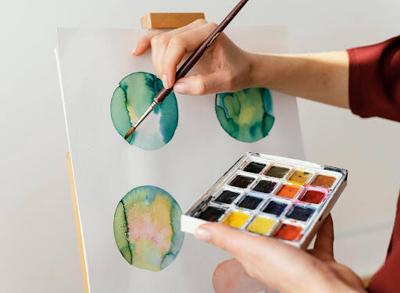
Watercolors are popular for a reason. Basically, they’re a type of paint you mix with water to create soft, varyingly translucent washes of color. Unlike their oil and acrylic alternatives, watercolors feel light and airy. As such, they can take your art in unpredictable directions, with the colors blending and bleeding in unexpected, often breathtaking ways.
Best of all, watercolor painting is approachable. As this article details, starting on your watercolor masterpiece is a relative cinch. If you’re looking to tap into your inner artist, consider the points below to start with watercoloring.
A Low Bar for Entry: Watercoloring Is Simple to Start
Whereas thicker mediums require all sorts of tools, cleaning products, and specialized canvases from the get-go, watercoloring is simple to start.
All you really need are watercolor paints, paper, and a brush. Once you determine where to get quality supplies in your area (or online), all that’s left is a quick and affordable shopping trip. Look for brand names like Winsor & Newton, Daniel Smith, Schmincke Horadam, and Sennelier, which each make quality products for various experience levels.
Don’t Cry Over Spilt Water: It’s a Forgiving Medium
Often, when your wrist slips up during a watercolor brushstroke, you end up creating something unexpected but equally marvelous. If you don’t like the mistake, you can lift the pigment with a damp, clean brush to erase most of the error. Similarly, you can paint over the translucent problem spot and effectively hide the blemish.
It’s a forgiving medium that allows beginners to experiment with and rework their creations to improve their brush-handling skills.
Take It Anywhere: Watercolors Are Portable and Convenient
Taking oil paints and an easel to the park is a production (which doesn’t stop some artists!). In contrast, toting your watercolor set and pad paper is a walk in the park—sometimes literally.
These paints are lightweight and compact, making it easy to practice painting in a variety of settings. Take your watercolors to a nearby park, café, or friend's house, or even paint a subject on the subway commute to work!
No Shortage of Tutorials: Beginner Watercoloring Resources Are Easy to Find
As mentioned in the introduction, watercolors are popular. The uptick of that popularity is that there are infinite resources out there on the craft of watercoloring. It all depends on a) how you prefer to learn and b) how deep you want to delve into the subject. You can find encyclopedia-length books on watercoloring at the local library, or brief tutorials on YouTube. You can take weeks-long courses at a local community center, or read a two-page blog on the topic.
At the End of a Long Day, Cleanup Is a Breeze
Mercifully, watercolors are a breeze to clean. Because the pigments are locked inside those hard paint disks, only activated by water, you don’t need much by way of cleanup—no intimidating solvents or dedicated detergents. All you need is some water, paper towels, fresh air, and time. And if you splash some paint on yourself in a creative fervor, don't worry: The stuff easily comes off of skin too.
If you’re getting started on your art journey, watercolors offer an ideal gateway. They’re relatively inexpensive, easy to learn, forgiving, portable, and easy to clean.
Here are some other articles related to your search:



(0) comments
We welcome your comments
Log In
Post a comment as Guest
Keep it Clean. Please avoid obscene, vulgar, lewd, racist or sexually-oriented language.
PLEASE TURN OFF YOUR CAPS LOCK.
Don't Threaten. Threats of harming another person will not be tolerated.
Be Truthful. Don't knowingly lie about anyone or anything.
Be Nice. No racism, sexism or any sort of -ism that is degrading to another person.
Be Proactive. Use the 'Report' link on each comment to let us know of abusive posts.
Share with Us. We'd love to hear eyewitness accounts, the history behind an article.